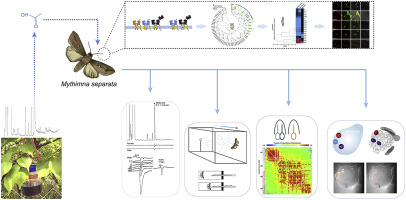当前位置:
X-MOL 学术
›
Insect Biochem. Mol. Biol.
›
论文详情
Our official English website, www.x-mol.net, welcomes your
feedback! (Note: you will need to create a separate account there.)
The olfactory reception of acetic acid and ionotropic receptors in the Oriental armyworm, Mythimna separata Walker.
Insect Biochemistry and Molecular Biology ( IF 3.2 ) Pub Date : 2020-01-02 , DOI: 10.1016/j.ibmb.2019.103312 Rui Tang 1 , Nan-Ji Jiang 2 , Chao Ning 2 , Guo-Cheng Li 2 , Ling-Qiao Huang 1 , Chen-Zhu Wang 2
Insect Biochemistry and Molecular Biology ( IF 3.2 ) Pub Date : 2020-01-02 , DOI: 10.1016/j.ibmb.2019.103312 Rui Tang 1 , Nan-Ji Jiang 2 , Chao Ning 2 , Guo-Cheng Li 2 , Ling-Qiao Huang 1 , Chen-Zhu Wang 2
Affiliation

|
Various insect species including moths have shown significant foraging preference to acetic acid. However, the olfactory reception and behavioral outputs of acetic acid in moths remain unsolved. The female adults of Oriental armyworm, Mythimna separata, exhibit high preference to acetic acid enriched sweet vinegar solutions, making them good targets for exploration of acid reception and performance. We first proved that acetic acid is an essential component which elicited electrophysiological responses from volatiles of the sweet vinegar solution. Successive single sensillum recording tests showed that at least 4 types (as1, as2, as3, and as4) of sensilla were involved in acetic acid reception in the antennae. The low dosages of acetic acid elicited upwind flight and close search, and pre-contact proboscis extension responses of the fasted females, indicating it serves as a food related olfactory cue. In vivo optical imaging data showed that low dosages of acetic acid activated one ordinary glomerulus (DC3), and high dosages evoked additional two glomeruli (DC1 and AC1) in the antennal lobe. A systematic survey on olfaction related receptors in three related transcriptomes has yielded 67 olfactory receptors (ORs) and 19 ionotropic receptors (IRs). Among, MsepIR8a, MsepIR64a, MsepIR75q1, and MsepIR75q2 were chosen as putative acid receptors by blasting against known acid IRs in Drosophila and comparing essential amino acid residues which related to acid sensing. Later in situ hybridization revealed that MsepIr8a was co-expressed with each of the other 3 Irs, suggesting its putative co-receptor role. This study reveals olfactory reception of acetic acid as an attractant in M. separata, and it provides the solid basis for later deorphanization of relevant receptors.
中文翻译:

东方粘虫Mythimna separata Walker对乙酸和离子受体的嗅觉接收。
包括蛾在内的各种昆虫种类均显示出对乙酸的明显觅食偏好。但是,飞蛾中乙酸的嗅觉接收和行为输出仍未解决。东方粘虫(Mythimna separata)的雌成虫对富含乙酸的甜醋溶液表现出高度的偏爱,使其成为探索酸接收和性能的良好靶标。我们首先证明了乙酸是从甜醋溶液中的挥发物引起电生理反应的必要成分。连续的单次sensillum记录测试表明,触角中的乙酸接收至少涉及4种类型的分子(as1,as2,as3和as4)。低剂量的乙酸引起禁食女性的逆风飞行和近距离搜索,以及接触前的鼻舌延长反应,表示它可作为与食物相关的嗅觉提示。体内光学成像数据显示,低剂量的乙酸激活了一只普通肾小球(DC3),高剂量引起了触角小叶中另外两个肾小球(DC1和AC1)。对三个相关转录组中嗅觉相关受体的系统调查显示,已产生67个嗅觉受体(OR)和19个离子性受体(IR)。其中,MsepIR8a,MsepIR64a,MsepIR75q1和MsepIR75q2通过对果蝇中已知的酸性IR进行爆破并比较与酸感测相关的必需氨基酸残基,被选作推定的酸受体。后来的原位杂交显示MsepIr8a与其他3个Irs共表达,表明其推测的共受体作用。这项研究揭示了嗅觉中乙酸作为分离物的诱因,
更新日期:2020-01-02
中文翻译:

东方粘虫Mythimna separata Walker对乙酸和离子受体的嗅觉接收。
包括蛾在内的各种昆虫种类均显示出对乙酸的明显觅食偏好。但是,飞蛾中乙酸的嗅觉接收和行为输出仍未解决。东方粘虫(Mythimna separata)的雌成虫对富含乙酸的甜醋溶液表现出高度的偏爱,使其成为探索酸接收和性能的良好靶标。我们首先证明了乙酸是从甜醋溶液中的挥发物引起电生理反应的必要成分。连续的单次sensillum记录测试表明,触角中的乙酸接收至少涉及4种类型的分子(as1,as2,as3和as4)。低剂量的乙酸引起禁食女性的逆风飞行和近距离搜索,以及接触前的鼻舌延长反应,表示它可作为与食物相关的嗅觉提示。体内光学成像数据显示,低剂量的乙酸激活了一只普通肾小球(DC3),高剂量引起了触角小叶中另外两个肾小球(DC1和AC1)。对三个相关转录组中嗅觉相关受体的系统调查显示,已产生67个嗅觉受体(OR)和19个离子性受体(IR)。其中,MsepIR8a,MsepIR64a,MsepIR75q1和MsepIR75q2通过对果蝇中已知的酸性IR进行爆破并比较与酸感测相关的必需氨基酸残基,被选作推定的酸受体。后来的原位杂交显示MsepIr8a与其他3个Irs共表达,表明其推测的共受体作用。这项研究揭示了嗅觉中乙酸作为分离物的诱因,











































 京公网安备 11010802027423号
京公网安备 11010802027423号